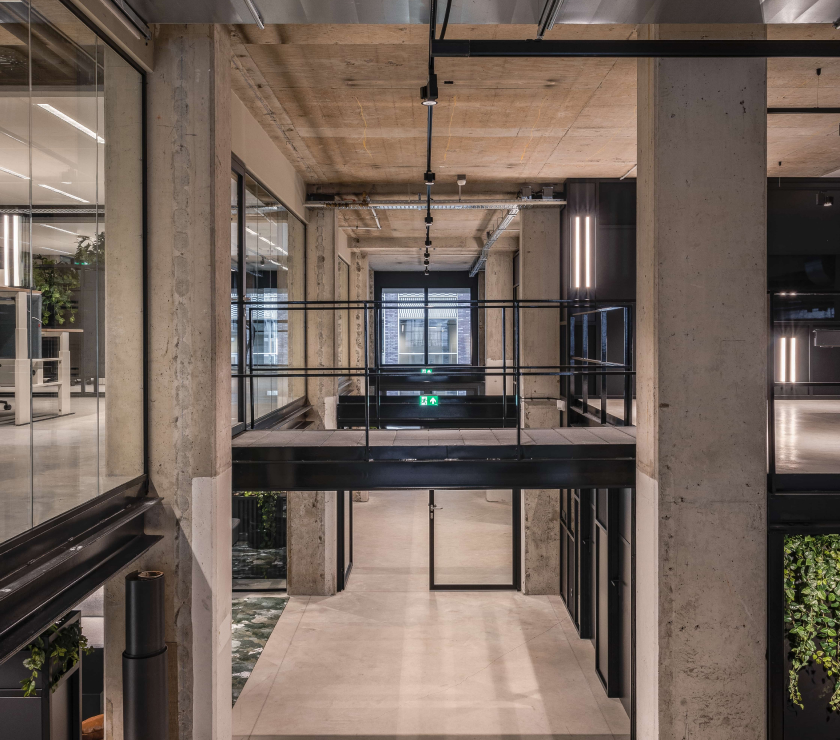Hexaware Strengthens Data Capabilities with Acquisition of Softcrylic Know More
This website uses cookies. By continuing to browse the site, you are agreeing to our use of cookies
AIOps Explained: Stages, Benefits and Use Cases
AIOps is a crucial strategy to address organizational challenges and streamline IT operations as companies increasingly move towards AI-driven solutions. AIOps leverages advanced analytics tools, including artificial intelligence (AI) and machine learning (ML), to automate IT tasks efficiently. Instead of replacing workers, AIOps empowers IT professionals to manage, track, and troubleshoot the complex issues inherent in digital platforms and tools. A significant increase in adoption is expected, with Gartner predicting that by 2026, over 80% of enterprises will have used generative AI APIs and models, up from less than 5% in 2023.
AIOps enables IT professionals to sift through the massive amounts of data generated by various digital platforms. This capability allows them to resolve problems quickly and, in some cases, anticipate and design solutions before issues arise. The AIOps market is projected to be valued at USD 27.24 billion in 2024, with anticipated growth to USD 79.91 billion by 2029, showcasing a compound annual growth rate (CAGR) of 24.01% over the forecast period spanning 2024 to 2029.
What is AIOps?
AIOps, or Artificial Intelligence for IT Operations, uses AI technologies like machine learning and natural language processing to enhance and automate IT service management and operational processes. By combining various individual, manual IT operations tools into a unified, intelligent, and automated IT operations platform, AIOps empowers IT operations teams to react faster, and even preemptively, to slowdowns and outages, providing complete visibility and context.
AIOps is the vital link connecting the expanding, ever-changing, and challenging-to-oversee IT environment with segregated teams. It also meets user demands for seamless application performance and accessibility. By gathering and examining data from various sources, it modernizes operations and provides proactive, customized, and immediate insights into IT operations.
Why is AIOps Important?
It is vital to recognize that the goal of AIOps isn’t to replicate human intelligence. Instead, AIOps aims to leverage algorithms to solve problems more swiftly, accurately, and at a larger scale than humans can manage. As applications become more complex and spread across various infrastructures—from data centers to public cloud to edge computing—it’s increasingly impractical for humans alone to ensure reliable performance at scale. Businesses adopting AIOps find that their teams can be more productive and devote more time to innovation when freed from tasks like troubleshooting, root cause analysis, and routine maintenance.
How Does AIOps Work?
AIOps improves IT efficiency by collecting, analyzing, and reporting vast amounts of data from various network resources, offering centralized, automated control. By leveraging AI, AIOps provides insights for managing organizational policies effectively. Even with non-AI automation, traditional IT operations require IT staff to initiate processes and handle numerous system alerts. This can lead to two main problems:
- Data comes from diverse sources—legacy systems, edge devices, cloud infrastructure, and user accounts—each with different platforms and formats.
- The high volume of alerts can cause alert fatigue, leading to overlooked urgent issues.
AIOps solves these problems by aggregating data from various sources into actionable insights, improving infrastructure visibility. It also correlates and prioritizes alerts, helping IT staff promptly address critical issues and threats.
Use Cases of AIOps
Exploring diverse applications of AIOps beyond traditional methods, such as root cause analysis and anomaly detection, reveals strategic solutions known as use cases. These use cases offer multifaceted approaches to enhancing operational efficiency and performance within IT landscapes.
- Optimize FinOps: Enterprises can optimize cloud costs and performance by implementing FinOps practices with AIOps. By leveraging data-driven insights, FinOps enables organizations to balance cost-effectiveness and application performance, reduce waste, and automate decision-making processes.
- Embrace Sustainability: AIOps facilitates the implementation of sustainable IT practices by optimizing data center operations. Through data-driven decisions on resource allocation, organizations can reduce energy consumption, lower carbon emissions, and promote environmental sustainability while maintaining operational efficiency.
- Streamline CI/CD: Enhancing CI/CD pipelines with AIOps-driven observability accelerates software delivery and ensures application quality. By leveraging AI and automation, organizations gain comprehensive visibility across the development lifecycle, facilitating rapid and reliable software releases.
- Optimize Application Performance: AIOps empowers organizations to optimize application performance by dynamically adjusting resource provisioning based on real-time demand. By automating cost optimization in cloud environments, AIOps helps organizations achieve optimal performance while minimizing costs.
- Strengthen Resilience: With AIOps, organizations can strengthen end-to-end IT resilience by leveraging real-time incident analysis and predictive IT management. Through proactive incident identification and resolution, AIOps minimizes downtime, enhances user experiences, and ensures uninterrupted service availability.
- Consolidate Tools: AIOps platforms simplify IT operations by consolidating monitoring tools into a centralized solution. Organizations can streamline incident management processes through AI-driven insights and automation, improve operational efficiency, and enhance employee experience.
What Are the Five Stages of AIOps?
Businesses and organizations undergo a transformation through five phases as they progress towards AIOps maturity:
- Reactive: In this initial phase, organizations operate in silos, gathering data on events solely for reactionary purposes. Generally, there’s minimal interaction between systems and the business, leading to a perpetual “fire-fighting mode.”
- Integrated: As organizations advance in their AIOps adoption, they consolidate data sources into a unified framework and enhance IT service management (ITSM). At this stage, silos are dismantled, fostering communication within the business.
- Analytical: Stage three entails implementing a cohesive analytics strategy, promoting data transparency for all stakeholders. Organizations improve ITSM processes and establish measurement criteria and foundational metrics.
- Prescriptive: By this stage, organizations prioritize automation, often incorporating machine learning. Automation becomes integral to ITSM processes, complementing human interaction. Comparative analytics are utilized to gauge enhancements and business impact.
- Automated: At the peak of maturity, businesses achieve seamless data sharing among stakeholders, complete automation without human intervention, and machine learning based on predictive models. Transparency in analytics is important, facilitating proactive decision-making grounded in business value.
Key Benefits of AIOps
The primary advantage of AIOps lies in its ability to quickly detect, tackle, and resolve slowdowns and outages, surpassing manual alert analysis from various IT tools. AIOps solutions include the following key benefits:
- Cost Efficiency: AIOps empowers organizations to extract actionable insights from vast data sets while maintaining a lean team of data specialists. Armed with AIOps solutions, these specialists complement IT teams, identifying operational issues accurately and avoiding costly errors.
- Efficient Issue Resolution: AIOps free up IT operation teams’ time for critical tasks by automating routine ones. This aids in cost management in intricate IT setups while effectively meeting customer demands.
- Swift Problem Resolution: AIOps furnishes event correlation capabilities, examining real-time data for patterns indicative of system anomalies. Through advanced analytics, operational teams can swiftly conduct root-cause analyses, optimizing service availability. Meanwhile, machine learning algorithms learn vital events from noise in data streams, allowing IT engineers to concentrate on significant matters.
- Predictive Service Management: Leveraging historical data analysis with machine learning technologies, AIOps enables proactive issue mitigation. ML models empower teams to preempt problems by detecting patterns imperceptible to human assessment, reducing disruptions to critical services.
- Streamlined IT Operations: AIOps eliminates the inefficiencies of working with different data sources, enhancing business processes and minimizing human errors. Offering a unified framework for consolidating information from various sources, AIOps facilitates seamless collaboration and workflow coordination among IT teams, boosting productivity.
- Enhanced Customer Experience: AIOps tools analyze vast data sets from multiple communication channels, enabling companies to understand and enhance customer interactions. Additionally, organizations can ensure optimal digital experiences by preventing costly service interruptions, maintaining service availability, and implementing effective incident management protocols.
- Facilitates Cloud Migration: AIOps streamlines the management of public, private, or hybrid cloud infrastructures, simplifying workload migration and reducing network complexities. This enhanced observability enables IT teams to seamlessly manage data across diverse storage, network, and application environments.
How Can You Implement AIOps?
The path to the AIOps platform varies across organizations. Once companies evaluate their position on the AIOps journey, they can begin integrating tools that enable teams to observe, forecast, and promptly address IT operational challenges. When considering tools to enhance AIOps within the organization, it’s essential to ensure they possess the following capabilities:
- Data Acquisition and Processing: AIOps gathers diverse real-time data, including logs, metrics, and events, to provide a comprehensive view of IT systems. Agents collect data from servers, networks, and applications and process them in ingestion pipelines for standardization and analysis. Techniques like data purification, normalization, and anomaly detection are applied, with machine learning algorithms playing a pivotal role in identifying patterns and trends. Processed data is stored in scalable repositories for efficient search and retrieval.
- Event Correlation and Incident Analysis: AIOps platforms succeed in correlating events and pinpointing the root causes of incidents or glitches within the IT infrastructure. By examining historical data and patterns, AIOps systems can quickly zero in on the source of a problem, thereby minimizing the mean time needed to repair (MTTR) and reducing downtime. Complex event processing systems reveal patterns and correlations in streaming data, recognizing significant events or incidents. These systems can initiate alerts or execute actions based on machine learning models or predefined rules.
- Automated Response Mechanism: An important advantage of AIOps lies in its capacity to automate remedial processes. Following the identification of a problem and the determination of its root cause, AIOps systems can instigate automated actions to resolve the issue. This includes reopening services, scaling resources, or implementing predefined scripts to mitigate the problem without human intervention.
- Proactive Insights through Predictive Analytics: AIOps facilitates predictive analytics by using historical data and machine learning algorithms to predict issues before they materialize. By inspecting patterns, behavior, and performance trends, AIOps can foresee future problems, helping IT teams tackle them and prevent potential disruptions. The infrastructure for training these machine learning models usually demands high-performance computing resources.
How Hexaware Can Help: Introducing Tensai® AIOps Automation Platform
Hexaware’s consistent acknowledgment as a frontrunner in Intelligent Enterprise Automation and AIOps, as underscored by our position as a Leader in the ISG Provider Lens™ study, resonates profoundly. Our Tensai® platform is a testament to innovation, catalyzing Digital ITOps with actionable insights, centralized AIOps observability, and a revolutionary AI-driven Automation Fabric.
For instance, a major global investment bank sought to enhance efficiency and user experience. Hexaware implemented Tensai®, transforming IT processes and reducing manual efforts. Key benefits included a 415% ROI over three years, a 98% success rate, 80% reduced cycle time, and 37% OpEx savings. The holistic approach involved automating over 30 use cases, significantly increasing operational efficiency and IT service adoption.
Tensai® is the paramount solution for comprehensive automation, revitalizing IT landscapes, and revolutionizing user experiences through tailored insights. Elevate automation proficiency, streamline IT functions, foster creativity, and unlock unparalleled business advantages with Tensai®.
About the Author

Gaurav Agarwal
Vice President, Cloud Ops
Gaurav Agrawal is the Vice President of Cloud Ops with an extensive 24-year career in the IT-ITeS, Cloud, Network, and Security domains. Currently, he serves as the Practice Head for Cloud Managed Services at Hexaware Technologies. He is recognized for his strategic global thinking, a passion for excellence, and an unfailingly positive attitude—traits that have branded him an intuitive and proactive leader. In his current role, he is responsible for the overarching Practice function for Cloud Managed Services, which encompasses Cloud Ops, Cloud Workplace, Cloud FinOps, Cloud Resilience, and Cloud Security. His strategic foresight was instrumental in managing the portfolios for Hybrid Cloud, Digital Workplace, and Security Practice until 2022, before he pivoted to focus on building the CMS practice as a dedicated service line.
Read more








